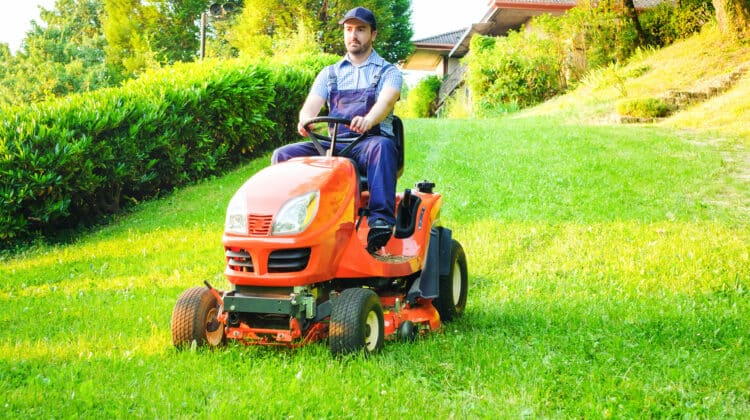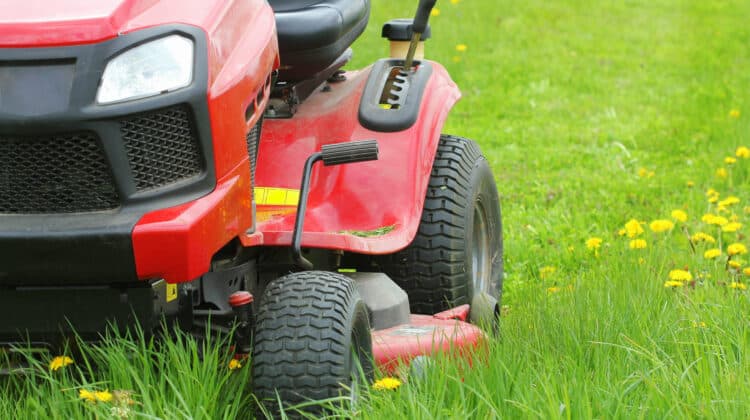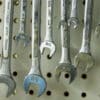Are you interested to find out how to adjust belt tension on riding lawn mower?
Lawn mowing is one of the most significant responsibilities that a homeowner must fulfill to make the lawn look great. You have to mow it just the right way, and combined with other external components in the yard, you can create a masterpiece of visual design.
To achieve this aesthetic, you have to make sure that your lawnmower is cutting grass the right way. If it is not mowing grass properly and leaving uncut patches on the lawn, there might be a problem with a loose drive belt.
Lucky for you, fixing a loose drive belt is not difficult, and you only need a socket wrench for the entire procedure.
Table of Contents
What are the steps in how to adjust belt tension on riding lawn mower?
The drive belt of a typical riding lawn mower is below the mower deck. It connects the transaxle pulley to the drive shaft of the engine and channels power and torque to the rotor blades.
After constant and extended usage, the quality of the belt will degrade and loosen due to the extension of the tensile cords.
If an extension is not significant, you can only adjust the belt tension to become tighter. If it is too degraded, then you have to replace it.
Here are the steps in adjusting the belt tension of a riding lawnmower:
- Examining the current mower belt
- Activating the mower’s parking mode
- Disconnecting the battery cable in the lawnmower
- Inspecting the mower deck
- Drive belt – Check if everything is complete and there are no missing components. Look if there are cracks and chunks of it missing. If there are, you do not have to adjust it anymore but replace it.
- Swingarm – Springs and pulleys are mounted on the swingarm. A pin is connected in one end of the arm and on the other is for rotating.
You have to make sure the whole arm can freely rotate, and if not, remove any residue or debris present and put some oil in its pivot. - Tightening the mower’s belt and adjusting the cable
- Reconnecting the mower’s power cable
- Testing the belt tension of the mower
Before doing the belt adjustment procedure, you have to check the current status of the belt if it needs to be tightened.
A typical riding mower has a blade engagement lever beside the steering wheel. Its function is to push the rotor blades to the grass as the cutting deck is lowered to the yard.
To check if the drive belt needs adjustment, turn on the ignition and increase to maximum the throttle lever. Then you have to engage the rotor blades by pressing the lever upwards.
If the blades instantly mow once the lever is pushed, then the drive belt is still tight.
If there is a whirring noise after pushing the lever, there is belt slippage, thus necessitating adjustment immediately.
Before undergoing the adjustment process, bring the riding lawnmower to an area with a flat surface so you can work properly. To enable parking mode, press the parking brake.
You also need to practice safety, so you have to disconnect the power cable to avoid being electrocuted./
At this stage, you already know that your riding lawnmower is not cutting grass properly because the drive belt is slipping.
Before troubleshooting this issue, you need to check on the status of the mower deck and its parts. Lower the mower deck by pulling the blade engagement lever.
And check on these components:
If these parts in the mower deck are properly functioning, unlock the blades by pressing the lever again. Also, check on the spring, which connects to a cable and is also attached to the lever.
Check if it is springy, stretched, and loose. Check on the belt at the same time if it is also loose, and if it is, then continue to the next step.
Lock the rotor blade lever since you saw that the belt is loose. Also, take note of the wire from the blade lever is connected to the springs. It is fastened to a bracket located on the mower deck.
Unscrew the bolts on the bracket and pull the wire towards you. Do not remove the bolts and loosen them.
Screw in the bolts back and check if the belt will also stretch and tighten. If it does, settle in the position and tighten the bolts by turning them clockwise.
Once done, check on the belt again to make sure the tightness is just right.
Once done, reattach the power cable to the battery.
Turn on the ignition of the mower engine to full throttle after pulling back the bracket. Push the lever upwards of the blade control lever and check if it will immediately cut the grass.
If you notice that the blades are cutting immediately, the belt has optimum tension.
But if the belt is still loose and the blades hardly cut the grass, the step did not work, which means you have to replace it with a new one.
What are the steps in replacing the drive belt on riding lawn mower?
If the belt drive is too degraded and tightening does not work, you need to replace it.
- Activating the mower’s parking mode – Before undergoing the replacement process, bring the riding lawnmower to an area with a flat surface so you can work properly. To enable parking mode, press the parking brake.
- Disconnecting the battery cable in the lawnmower – You also need to practice safety, so you have to disconnect the power cable to avoid being electrocuted.
- Disengaging the mower’s sparkplug wire – At this stage, the ignition is off, and no electricity is flowing in the engine. It is because the battery cable has been disconnected.
Another safety precaution is to disconnect the sparkplug wire, so lift the hood and look for it to detach it. - Disassembling the mower deckTo start in disassembling the mower deck, lock the blades and lower the deck by pushing the engagement lever.
Remove the drive belt from the engine pulley, which is attached to the drive shaft, and also release the belt holders. - Detaching the mower deck from the main body – You will need to disconnect the mower deck from the body. It is done by removing the supports linking the mower deck to its body from both sides.
Remove all washer support and retaining pins from the lift links, suspension arms, and rear end brackets.
You have to be aware that once all the abovementioned components are removed, make sure that the detachments are done from both sides. - Taking a picture of the belt in the mower deck – You will need to document the positioning of the belt on the deck and its passage through the pulleys by taking a snapshot on your smartphone.
- Removing the old mower belt – Take out the belt wrapped around the three pulleys, which are two mandrel pulleys and one idler pulley.
- Attaching the new belt to the mower – Fasten the new drive belt by wrapping it around the idler and mandrel pulleys, and be sure it also goes through the belt keeper.
- Reattaching the mower deck – In assembling the mower deck back, reattach the lift links, suspension arms, rear-end brackets, and other supports.
Use the retaining pins and washers to secure the linkages and connect the battery to the engine pulley. - Testing your lawnmower – With everything assembled and attached back to the original position, lift the hood to reconnect the sparkplug.
Key in the ignition switch and drive through a grassy area to check if the belt replacement procedure worked.
If not, then the drive belt is not the problem, which means you need to take it to a repairman to get fixed.
What are ways for the drive belt to become defective and fall off the mower?
- Too much pitch – Check how the drive belt is positioned on the mower deck. The front pitch should be one-eighth to one-fourth inch lower from the back. The drive belt will slip if the pitch is more than that.
- Defective parts – Check on the pulley system, swingarm, and other components connected to the drive belt if they might be defective.
- Debris buildup – Check if there is dirt amassing between the bracket and pulleys and the drive belt itself, which decreases belt friction.
Does learning about how to adjust belt tension on riding lawn mower important?
It is, and when your riding lawnmower is not cutting grass as it is supposed to, the drive belt is the likely culprit. Once it will happen, you already know what to do to fix it.





